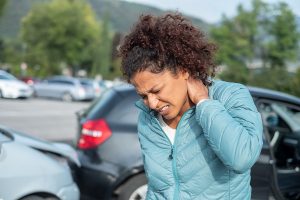Rear-end collisions happen all the time, and they are so common that many people mistake them as being no big deal. Insurance companies also perpetuate the myth that all rear-end crashes are minor since this helps them to minimize payments to victims of this type of accident. The reality is that many rear-end collisions can have disastrous and costly impacts on a person’s life.
Indeed, even though many of these accidents occur at low speeds, they could produce forces strong enough to cause soft tissue injury, especially in the neck and knee areas of the body, as well as other traumatic injuries. Anyone injured in a rear-end collision should discuss their rights with a car accident attorney today.
Rear-End Collision Statistics

According to the National Highway Traffic Safety Administration (NHTSA), rear-end collisions account for approximately 29 percent of all traffic accidents resulting in serious injury. Other statistics indicate that rear-end collisions account for over seven percent of all traffic-related fatalities in the United States, and nearly 20 percent of those fatalities involve two-vehicle collisions.
Common Causes of Rear-End Collisions
Driver distraction and inattentiveness is the main reason for rear-end collisions. Drivers might assume that since they are driving at lower speeds or in traffic that it is the appropriate time to multitask. They might start to do things that take their attention away from driving, which is always a disaster waiting to happen.
Thus, a vast majority of rear-end collisions happen due to:
- Failure to see and obey traffic signals, signs, or officers
- Using a smartphone to text, peruse social media, tuning the radio, or having a distracting or excited chat with a passenger.
- Failure to obey posted speed limits, tailgating, or not paying attention to road conditions – all of which can cause a driver to hit the vehicle in front of them that may have stopped or slowed down due to traffic signs or road conditions.
Types of Injuries Common in Rear-End Crashes
One common injury from a rear-end collision is whiplash. This is a soft-tissue injury that happens due to the force of impact on the victim during the crash. When the vehicle behind hits the one in front, the body of the person in the car in front jerks and moves with the impact, and their head can snap forward and back again, much like a whip.
Soft tissue injuries are not always immediately or readily apparent, so if you have been in a rear-end collision, see a doctor immediately following the accident or as soon as possible. The doctor will then properly examine and offer a diagnosis, identifying injuries you may not know you suffered. This information will be critical down the road when you pursue a personal injury claim.
Lower back and knee or leg injuries are also common following a rear-end crash. The seriousness of these injuries depends on the severity of the rear-end collision.
Other injuries include:
- Dislocations
- Sprains, strains, and tears to ligaments, tendons, or muscles
- Concussion
- Herniated discs
- Bruising or burns from airbag deployment
How to Determine Fault in a Rear-End Collision
Connecticut law is unambiguous on who is at fault in a rear-end collision. The relevant law provides that “No driver of a motor vehicle shall follow another vehicle more closely than is reasonable and prudent, having regard for the speed of such vehicles, the traffic upon and the condition of the highway and weather conditions.” Thus, the driver who rear-ends another vehicle is often the one who is at fault since they should be following far enough away to stop in time and avoid a collision.
However, a car accident lawyer examines other factors to determine fault – including traffic, weather, and road conditions. It may also be the case that the crash was unavoidable owing to auto parts failure or some malfunction that the driver was unaware of until the collision occurred.
What to Do if You’re in a Rear-End Collision
The first thing to do when a rear-end collision occurs is to remain calm. Take a deep breath and tell yourself it will be alright, and this is critical, especially if you have a medical condition that may worsen with unnecessary excitement, such as high blood pressure.
If you or someone else suffered injuries, call 911 immediately. To the extent it is possible, pull your car over to the side of the road so as not to block traffic. Wait for the police to arrive and make sure you give them your full cooperation.
If your injuries are not too severe and you can do so safely, document the accident scene and evidence by taking video and still photos of the accident location, damage to both vehicles, the license plate of the other driver, and take their driver’s license information, including name and address, names and contact information of witnesses.
Exchange your name, contact information, and car insurance information with the other driver, but do not let them take a photo of your driver’s license as doing so may expose you to the risk of identity theft.
If you can, take time to write down what happened before the rear-end collision occurred while this information is fresh in your mind. Make sure to include the time and date, location, and weather conditions, make and model of the other driver’s car, and anything else that can help establish what happened at the scene
What a Car Accident Lawyer Can Do for You
If you were in a rear-end collision, consult a car accident attorney who can evaluate your case and give you legal advice on the best way to obtain full compensation for your injuries. Once the lawyer establishes that you have a personal injury case based on the negligence of another driver, they can prepare and file a strong car accident case against an insurance company or in civil court.